According to Edgar Emerson in the History of Alexandria, New York,
Westminster Park was informally organized in 1875. This date is confirmed by numerous accounts in the newspapers across Northern New York in the fall of that year. It was reported that a new grounds, at the foot of Wells Island would be purchased and developed as a religious summer resort under the auspices of the Presbyterian Church. It would be organized as a stock company and the gates would be thrown open to those who behave themselves without paying the fee of twenty-five cents required at some other established parks. It was said, this cozy, romantic point on the Saint Lawrence could be reached by the forthcoming Redwood and Alexandria Bay Railroad, and by all means of River navigation. (The Redwood to Alexandria Railroad did not come for a number of years.)

By the end of December 1875, Watertown news correspondents announced that Hon. A. Cornwall, a well-known land investor and businessman, would be one of the directors of the new enterprise and that a meeting would take place before the New Year.
Emerson reports that the articles of association of Westminster Park were filed on January 3,1876. In an 1878 article, it was noted that the Association was incorporated under the laws of the State of New York. Although the community was organized under the auspices of the Presbytery of St. Lawrence, the Presbytery of Utica, and the Synod of Central New York, it was not intended to be sectarian and offered welcome to various denominations and beliefs. “The object of this community was to furnish a summer resort that would be free from the objectionable features that attach to all fashionable watering places, and at reasonable charges for entertainment.” (from the Watertown Re-Union on May 09, 1878.)
Directors elected in February 1876, included Hon. Norris Winslow of Watertown, Hon. S. G. Pope of Ogdensburg, William S. Banks of Canton, Jno D. Ellis of Antwerp, Hon. A. Cornwall of Alexandria Bay, William S. Taylor of Utica, Timothy Hough from Syracuse, George Gilbert of Carthage, and R. C. Collis of Theresa. Plans were discussed for laying out roads and lots and the construction of a large chapel. It was reported that the land had been purchased. (It had not.)
March 1876 saw many reports on the proposed project couched in the most glowing terms: five hundred acres… ornamental shade from trees… large amount of stock sold to provide for the construction of landing places, walks, a chapel, a boarding house with postal service and telegraph lines…all needs afforded for comfort, enjoyment, and religious advantages. The glowing report concluded with a pitch for investment opportunities.
Suddenly the 1876 reports quieted down. The exception was one notice of an excursion to the property in mid-August, to which everyone was cordially invited to attend. Round trip tickets available for one dollar.
In the Spring of 1877, activities picked up! A meeting was held to discuss the project. It was explained that when the association was first formed, economic times were in a slump. Additionally, it was America’s centennial year and attentions were elsewhere. There was a United States Presidential election to be won, and 1876 was not a year to solicit funds. Enough stock had been sold to purchase the land, but Trustees felt that twice that amount would be needed to provide improvements necessary for the community to entice investors to buy stock, a lot, or a cottage.
The Westminster Trustees were savvy businessmen. They appointed O. C. Brown of Adams to be the General Agent of the Board of Trustees. His task was to complete the subscriptions of capital stock. Brown organized excursions of potential investors from cities in Central and Northern New York. A number of his invited guests later became lot purchasers, and some even became Park Trustees. The Presbyterians negotiated travel deals with free and reduced fares for railroad trips and steamship service. The Crossmon Hotel opened early for these excursionists. Dinners were offered at the Crossmon and Thousand Islands Hotel at budget prices. Inexpensive trips to the Thousand Islands were snapped-up by hundreds of people.
These trips continued through the summer of 1877. A report in the Watertown Daily Times on July 16, 1877, mentioned that noted photographer, A. C. McIntyre, was on one excursion. He “took a picture of the party”. Could this stereo view show that moment in time?
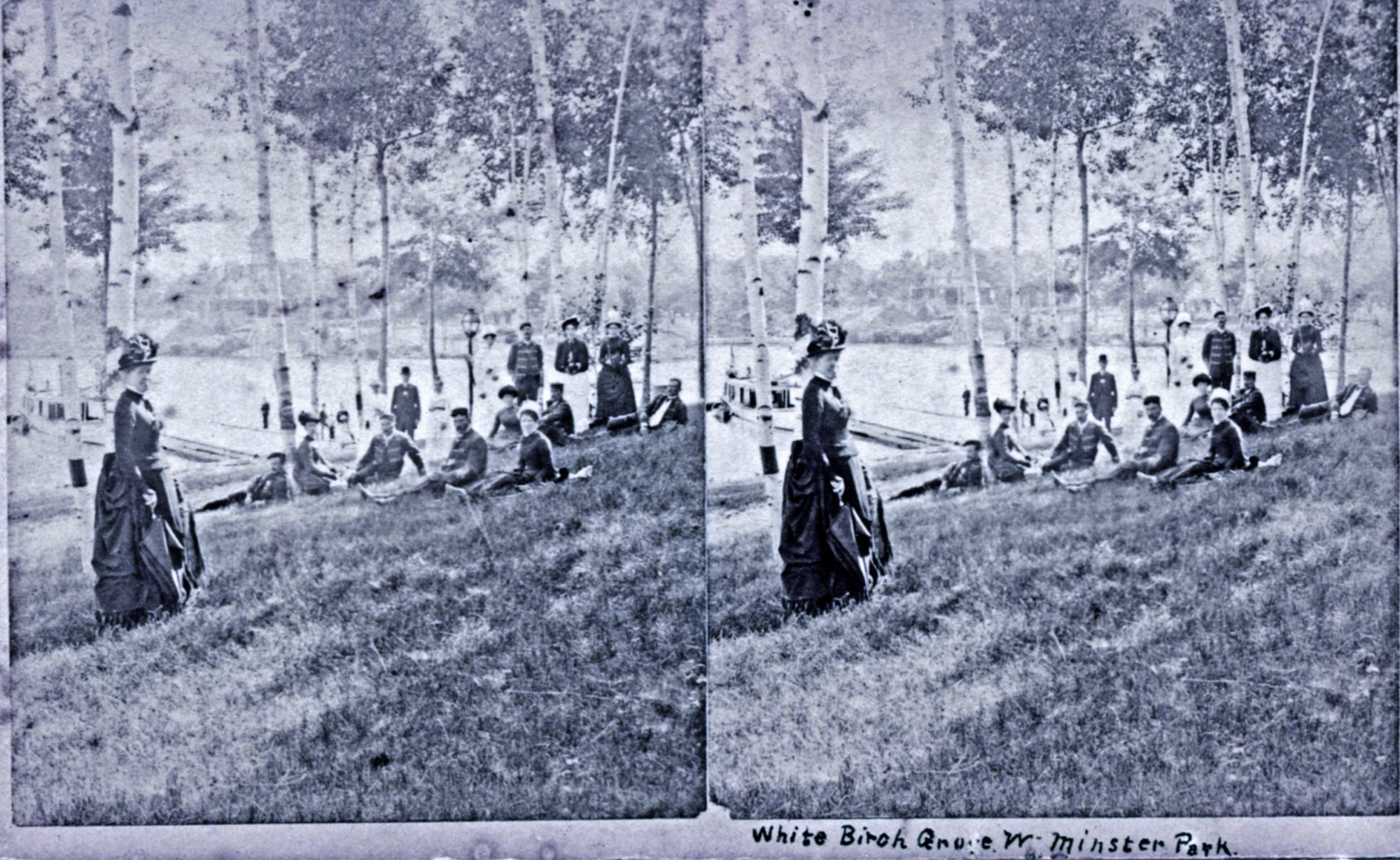
Park Trustees courted the favor of many Central New York newspapers. Board meetings were attended by representatives of the Utica Herald, the Utica Observer, the Watertown Dispatch, the Syracuse Standard, the Syracuse Currier (sic), the Syracuse Journal, and many other papers. Some editors bought stock in the project. A few became trustees and cottage owners. For decades, reporters continued to publicize Westminster Park with glowing reports of conditions and activities which were published weekly in summer months.
Cooperation from the New York railroads, hotels, and steamship lines was not unexpected, as many of the businessmen in Central New York saw the potential to create an easy pathway from Utica, Syracuse, or Watertown, to these newly developing island communities. For example, the Utica and Black River Railroad had been revitalized by capital from T. S. Faxton and John Thorn. T. S. Faxton also invested heavily in the steam ship lines. Lot 71 in Westminster Park was purchased by T. S. Faxton (though some say, by his niece Mary Powell.) John Thorn left a substantial sum to his niece, Josephine Maynard, who visited Sunset cottage in 1880 and later in life purchased several properties along Lake Avenue. Clearly, there was an alliance of friends and family in these investments.
Church leaders contributed to spreading the message. Many citizens from Utica followed Rev. Dr. P. H. Fowler of the Utica Presbyterian Church. He helped launch Westminster Park by extolling the virtues of the island to his congregants, serving as the first president of the Westminster Park Trustees, and leading the dedication services at the Bethune Chapel. (Sadly, died in 1879.)
The desire of the Trustees to court the favor of investors was keen. The Westminster Park Trustees had adopted a “pay-as-you-go” philosophy. The land purchase and the development of the basic community was estimated to require at least $50,000. The vision was to sell capital stock of five hundred shares at $100. per share. Time became an issue as they negotiated the land purchase from Captain Horatio Nelson Throop of Pultneyville, NY, with a refusal clause on a limited time. Negotiations proceeded through the summer of 1877. By August, the Trustees were confident of their financial status and their agreement with Throop. They authorized a survey of the property. Civil Engineer F. A. Hinds and his assistant, Rev. Mr. Rockwell and others worked on laying out the community’s streets and determining sites for the Hotel, docks, and public buildings. By October, Captain Visger and his crew were “opening up the principal avenues.
Hinds was commissioned to create a map of Westminster Park. Plans continued for the sale of lots the next spring, the designs of the Hotel, docks, chapel, and private cottages. Contests were devised for local architects to submit designs for the chapel and for four basic cottage designs. It was determined that docks would be built on both sides of the island. One would be on the Canadian side, where deeper water would allow larger ships to dock. The other would be constructed on the American side of the property, facing Alexandria Bay, to allow for smaller sailing and steamboats. It was agreed that a direct tax might help to pay expenses.
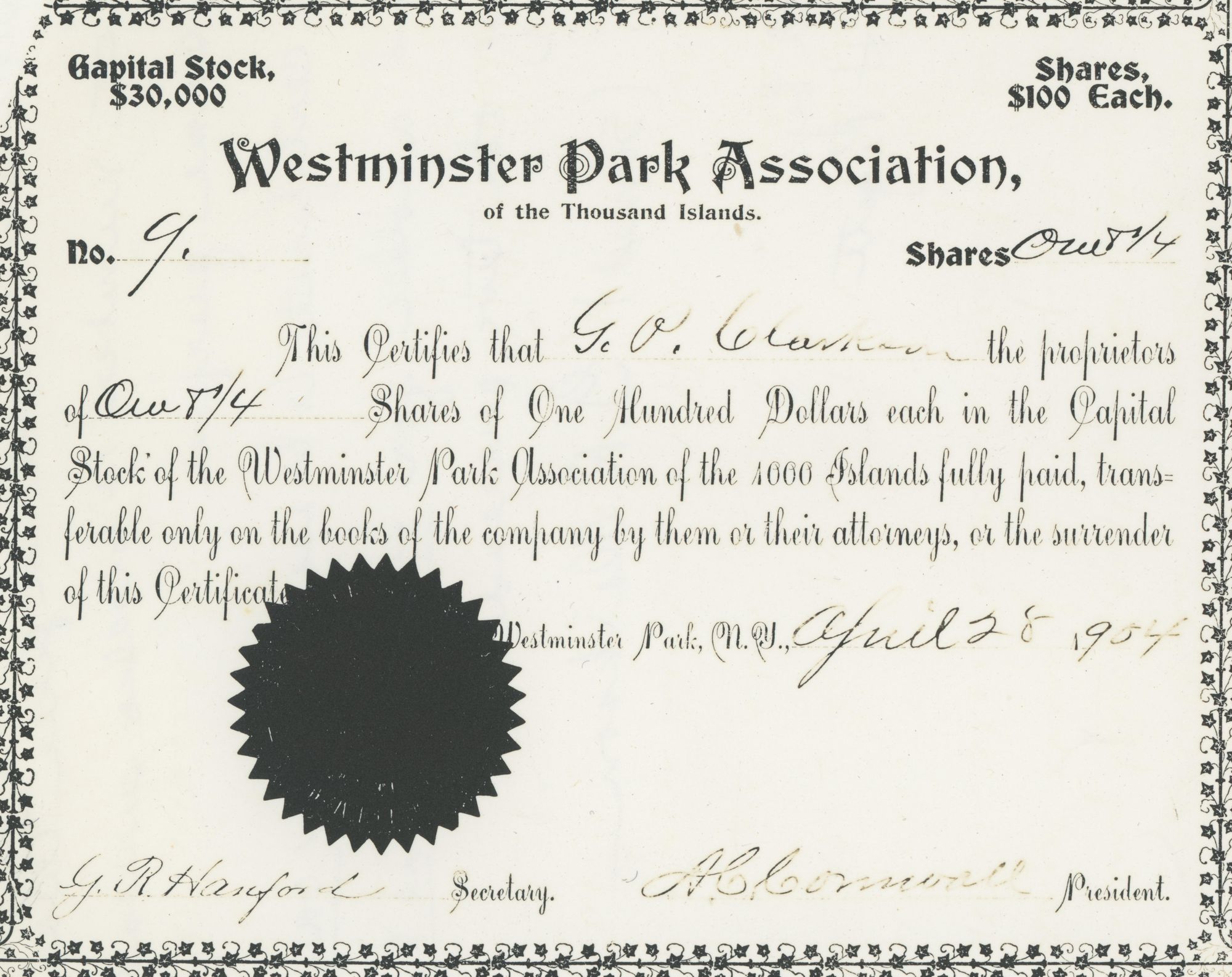
1878…. ready, set, build!
Early January 1878 saw a report that the roads are nearly all graded and the underbrush all cleared away. Work on dock construction was halted waiting for the ice to set in. Meanwhile, the trustees were asking for sealed proposals for the building of the boarding house.
By the third week of January, winter had come, the ice had formed, and the construction of the Westminster Park Long Dock began. Captain Visger was the superintendent of the project. Visger’s crew was driving piles at the rate of thirty per day working on the ice. Newspapers described the progress at weekly intervals. By the end of the first week of February 1878, seven hundred and eighty piles had been driven. Four hundred feet had timbers in place and were ready for the planking. By the first week of March, the dock structure reached 1100 feet in length and planking began. It was described as one hundred and sixty feet of dock, and over one thousand feet of bridge-way. Plans were underway to add a warehouse with a sitting room on the end.
This is the dock that confounds many twenty-first century citizens. It was within Westminster Park property on the side facing Alexandria Bay. This dock was directly across from the Thousand Islands Hotel, which is now the site of today’s River Hospital. After the demise of the Westminster dock, this was the location of the better known Peacock Boathouse, just up from the Boldt Yacht House.
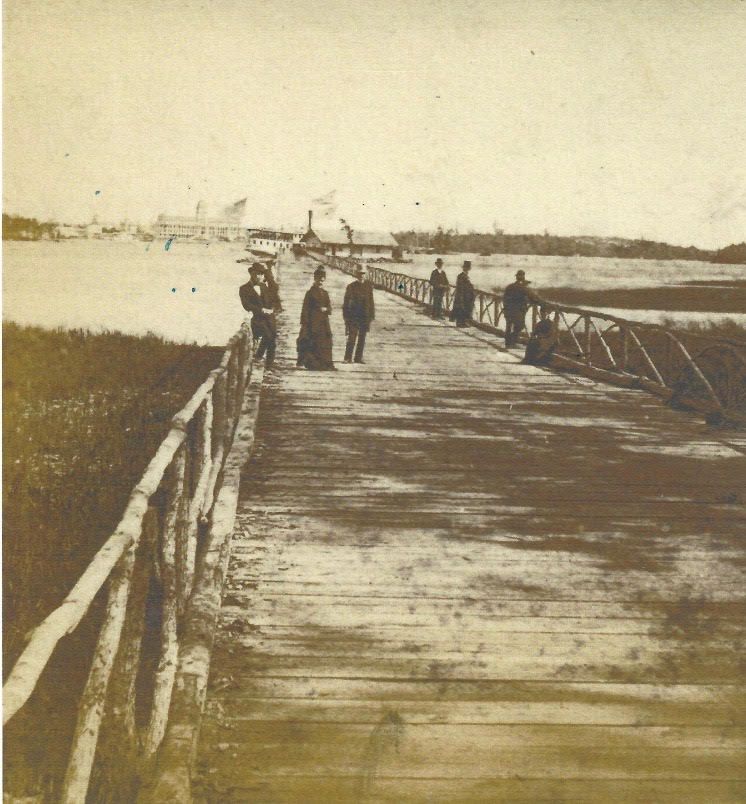
In May of 1878, the directors ordered that an additional dock be built “on the Canada side of the island”. (Poplar Bay) The work on fourteen miles of graded avenues and bridle paths continued. One hundred acres of Park property had been cleared of underbrush. Engineer Frank Hinds began to stake out the lots. As May approached, Superintendent Visger doubled the number of teams to spread gravel on the roads. His intent was to put on twenty teams.
The Trustees continued to meet on a regular basis. In April, Trustee Patrick H. Agan, a Syracuse postmaster, abolitionist, and printer and newspaperman, prepared a “prospectus” containing a large map of Westminster Park, views of the proposed buildings, and pages of descriptive text to promote interest in the community. It was distributed free of charge to interested parties.
The Hotel complex was a major feature of the community. It was described in the prospectus and in news reports as follows: “The Boarding Hall stands upon a gentle slope, easterly from Mount Beulah, and within a dozen rods of the clear waters of the Bay. It is a two-story structure with broad verandas; the main building is in the form of a letter L, eighty by thirty-six feet in one direction, and sixty-six by thirty-six feet in the other. The first floor is devoted to the Dining-Room, Sitting-Room, Offices, &c., while the second floor is divided into Parlor, suites of rooms, single rooms, &c., for guests. The entire building is lathed, plastered and painted throughout; it is supplied with pure River water…A number of rooms open out upon the broad piazza a few rods from the archery fields and game grounds, and the whole panorama of the St. Lawrence River, including Alexandria Bay, with its large hotels and the little Canadian village of Rockport, are all brought into full view.” The Boarding House was constructed by the Sheeley Brothers of Theresa, NY.
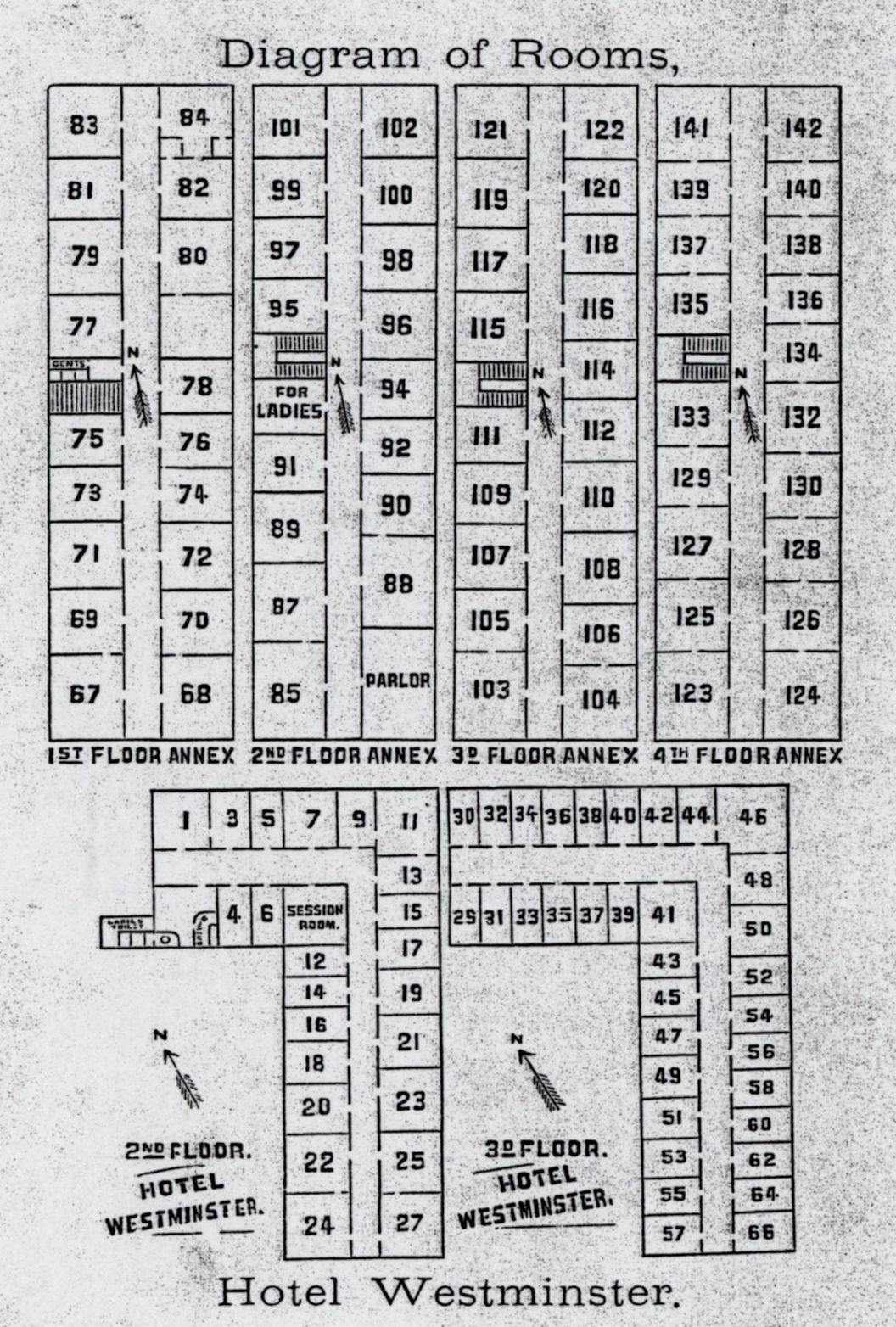
The Westminster Park Association had dubbed the Hotel as “Park House”. The first proprietors were Frank Steele, formerly of the Delevan in Albany, and P. W. Dalton of Adams. The experienced hoteliers rented the Hotel “for a term of years.” It had been hoped that the Hotel would open in time for the lot sale in May, but several weeks of June passed by before they were ready for business. The new hotel managers hired Mr. Rockwell, an old hotel man of New York, to preside over the office. Mr. Steele supervised the book-keeping. Mr. Dalton took charge of managing the boats and renting the tents and cottages. Sail and row boats were available for hire with expert oarsmen provided. Mrs. Dalton ran the food service. Great thought was given to provide for the comfort of the guests, including hot and cold running water on all floors and all modern improvements. Livery service was provided as well. “Carriages would run to and fro from all boats, free of charge, for all guests of the hotel.” Pulaski Democrat, June 1, 1878. Horace Scripture of Sandy Creek ran the Livery.
There were whispers of a few select individuals buying a building lot early in the spring. The main lot sale, advertised far and wide, was held on May 23, 1878, a blustery day, in the storehouse of the long dock. Many interested parties had come to the Saint Lawrence one day in advance, staying at the Crossmon Hotel and the Saint Lawrence Hotel. More soon followed. Cottages began to spring up within a few weeks. [Details of that event, see thousandislandslife.com 1878: Sale of Lots in Westminster Park by Linda Twichell, June of 2018, Reports say that seventy-six lots were sold that day.]
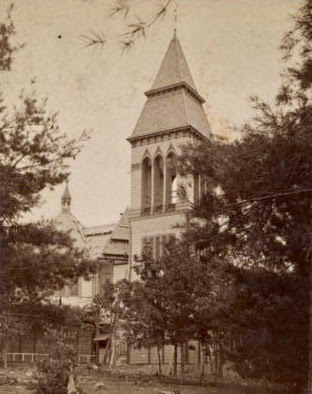
The crowning jewel of this Presbyterian community was the Bethune Chapel, built upon the highest point of Wellesley Island, Mount Beulah.
This chapel had been designed by Architect W. H. Hamilton of Utica. It was built by Mr. F. Kessing of Ilion. Details of the construction of this beautiful church and its glorious dedication ceremony can be found in my article, “Westminster’s Bethune Chapel, 1878”, in the March 2018 edition of thousandislandslife.com. This Chapel is another subject of historical controversy, for some say it was never constructed. Stereo views by James Esson refute that legend and more images can be found in the thousandislandslife.com article.
Once investors purchased their lots, a frenzy of activity overtook Westminster Park. A number of cottages were built in 1878. Among them were the twin cottages of D.W. Northrup of Utica, and V. B. Stewart of Utica, as well as the cottage of William June of Pulaski. The community continued to grow from those early days and many more stories wait to be told.

A day at Westminster Park will convince any that it is the most desirable summer resort on the River.
By ©Linda Twichell 2020
Linda Lewis Twichell, a fifty-seven-year resident of Westminster Park, has collected historical information on the Westminster community, since the 1970’s. Linda is a regular contribute to TI LIfe and her research focuses on the lives of the people who settled in the Park, in the last quarter of the 19th century, and the cottages they built. A book of Westminster Park, its people, and their stories is in the works. Be sure to check out Linda’s other historical research published in previous issues of TI Life.
Posted in: Volume 15, Issue 4, April 2020, Places, People, History
Please click here if you are unable to post your comment.
